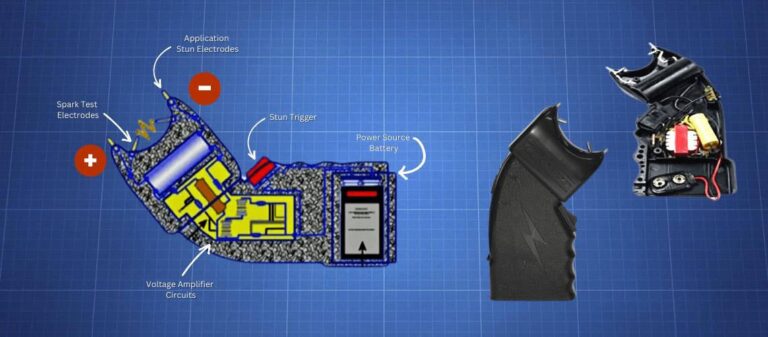Table of Contents
- Choosing the Right Tools for Measuring Stun Gun Battery Voltage
- Step-by-Step Guide to Safely Testing Your Stun Gun Battery
- Interpreting Voltage Readings to Assess Battery Health
- Maintenance Tips to Prolong Your Stun Gun Battery Life
- In Retrospect
Choosing the Right Tools for Measuring Stun Gun Battery Voltage
Selecting the appropriate tools for testing your stun gun’s battery voltage is crucial for obtaining accurate and reliable readings. Digital multimeters are highly recommended due to their precision and ease of use. Look for a model with a clear LCD display and auto-ranging capabilities to simplify the measurement process. Additionally, ensure the multimeter has a voltage range suitable for low-voltage devices-typically between 0-20V DC. While analog multimeters can work, they often lack the accuracy needed for modern stun guns, potentially leading to misinterpretation of the battery’s true state.
Besides the device itself, consider the accessories and features that enhance safety and functionality. Insulated probes are a must-have for preventing accidental shocks, especially when working with electroshock devices. Some advanced testers offer data hold functions, allowing you to freeze the reading for easier documentation. If you’re frequently testing batteries, investing in a durable case with storage compartments for leads and extra batteries can help keep your tools organized and protected. By tailoring your tool selection to the specifics of your stun gun and testing environment, you’ll maximize accuracy and extend the life of your essential device.
Step-by-Step Guide to Safely Testing Your Stun Gun Battery
Begin by gathering all necessary tools, which include a reliable digital multimeter, insulated gloves, and a safe, dry workspace free from clutter. Before handling your stun gun, ensure it is turned off and disconnected from any power sources. Safety should be your top priority; wearing gloves will prevent accidental shocks. Next, locate the battery compartment, usually accessible by sliding or unscrewing the panel. Carefully remove the battery, taking note of its orientation so you can reinstall it correctly. Inspect the battery for visible signs of damage, such as corrosion or leakage, which could affect performance or safety during testing.
With the battery removed, set your multimeter to measure DC voltage and select a range higher than the battery’s nominal voltage to get an accurate reading. Connect the multimeter probes to the battery terminals – red to positive, black to negative. Hold the probes steadily, and observe the voltage displayed on the screen. Interpret the results by comparing the reading to the manufacturer’s specifications; a fully charged battery should be within a certain voltage range, while a significantly lower reading indicates it’s time for replacement. After testing, reinstall the battery carefully, ensuring the terminals align with their respective contacts, then securely close the compartment before powering your device back on.
- Always handle batteries with dry hands and in a non-conductive workspace.
- Double-check your multimeter’s settings before starting.
- Dispose of faulty batteries responsibly and in accordance with local regulations.
Interpreting Voltage Readings to Assess Battery Health
Understanding the voltage readings from your stun gun’s battery is crucial in gauging its performance and reliability. A fully charged stun gun battery typically reads around 3.7 to 4.2 volts when measured with a voltmeter, depending on the battery type and manufacturer specifications. If the voltage drops below this threshold, especially under load, it signals that the battery is losing its charge capacity or nearing the end of its lifespan. Keep in mind that batteries showing a voltage below 3.3 volts might still work for a short period, but they won’t deliver the full power necessary for optimal stun gun operation.
When assessing your voltage readings, here are some critical points to consider:
- Consistent Voltage Drops: A sudden or steady decrease in voltage over several tests indicates internal battery degradation.
- Load Testing: Measuring voltage under load-the moment the stun gun is activated-provides a realistic view of the battery’s performance rather than a no-load measurement.
- Voltage Fluctuations: Inconsistent readings can point to faulty connections or a failing battery, both of which require immediate attention.
By carefully interpreting these voltage readings, you ensure your stun gun remains dependable, keeping you safe and ready when it matters most.
Maintenance Tips to Prolong Your Stun Gun Battery Life
To ensure the longevity of your stun gun’s battery, it’s essential to maintain proper charging habits. Avoid letting the battery drain completely before recharging, as deep discharges can significantly reduce battery life. Instead, aim to charge the battery once it dips below 20%. Additionally, use the manufacturer’s recommended charger to prevent overvoltage or overheating. Keeping the stun gun in a cool, dry environment also prevents battery degradation caused by excessive heat or moisture exposure.
Regular maintenance can be easily incorporated into your routine with a few simple steps:
- Periodically check the battery terminals for corrosion and clean them with a dry cloth.
- Perform voltage tests monthly to spot early signs of battery wear.
- Store the stun gun at approximately 50% charge if it won’t be used for extended periods.
- Avoid frequent partial charges that lead to inconsistent voltage levels.
In Retrospect
Accurately testing your stun gun battery voltage is a crucial step in ensuring your device functions reliably when you need it most. By following the proper procedures and using the right tools, you can maintain your stun gun’s performance and extend its lifespan. Regular voltage checks not only help you avoid unexpected power failures but also give you peace of mind knowing your personal safety device is always ready. Remember, a little routine maintenance goes a long way in keeping your stun gun in top shape. Stay safe and stay prepared!Check Our Other Blogs
- StunGun – Your Trusted Source for Stun Guns, Laws, and Self-Defense Tips
- PepperSprayLaws – Your Trusted Resource for Pepper Spray Information
- StunGunLaws – Your Trusted Guide to Stun Gun Legality and Safety





